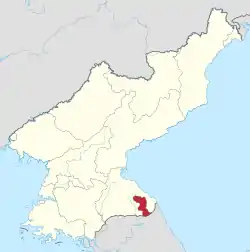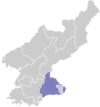Mount Kumgang Tourist Region
The Mount Kumgang Tourist Region is a special administrative region of North Korea. It was established in 2002 to handle South Korean tourist traffic to Mount Kumgang (Diamond Mountain). It was one of the symbols of the South Korean Sunshine Policy.[1]
Mount Kumgang Tourist Region | |
|---|---|
special administrative region of North Korea | |
| Korean transcription(s) | |
| • Hangul | 금강산 관광 지구 |
| • Hanja | 金剛山 觀光 地區 |
| • Revised Romanization | Geumgangsan Gwan-gwang Jigu |
| • McCune–Reischauer | Kŭmgangsan Kwan'gwang Chigu |
| Short name transcription(s) | |
| • Hangul | 금강산 |
| • Hanja | 金剛山 |
| • Revised Romanization | Geumgangsan |
| • McCune–Reischauer | Kŭmgangsan |
 | |
 | |
| Country | North Korea |
| Region | Yeongdong |
| Government | |
| • Type | Tourist Region* |
| Area | |
| • Total | 530 km2 (200 sq mi) |
| Dialect | Kangwŏn |
| |
History
Development and boom period
Beginning in 1998, South Korean and other foreign tourists were allowed to visit Mount Kumgang, traveling at first by cruise ship, and then by bus on a newly built road through the Korean Demilitarized Zone. In 2002, the area around the mountain was separated from Kangwon Province and organized as a separately administered Tourist Region, covering 204.6 square miles (530 km2).[2] From 1998 to July 2008 over one million South Koreans visited the resort.[3] The resort is home to Hotel Haegumgang, a floating hotel that first operated on Australia's Great Barrier Reef.[4] Much of the infrastructure in the area has been built by the South Korean Hyundai Asan company which received a 30-year exclusive deal to develop the region.[5][1] In addition to hotels, it was also to include golf courses, ski resorts and other facilities.[1][6] Developed facilities included Kumgangsan Hotel and Oikumgang Hotel, the former described as the "flagship hotel" for the region.[7][8] By 2007 the region has reported more than 1.7 million visitors.[5]
Winding down and North Korean takeover
.jpg.webp)
In July 2008, Park Wang-ja, a 53-year-old South Korean tourist, was shot twice and killed when she entered a military area, according to the North Korean government.[9][3] The South Korean request for a joint inquiry was denied. Forensic tests done on Park suggest that she was standing still or walking slowly when shot. This contradicted the North Korean claim that she was running and did not heed warnings. Immediately after the shooting, the South Korean government suspended tours to the resort. In August 2008 the North Koreans announced that they would expel "unnecessary" South Korean workers from the resort.[10][11]
In March 2010, the DPRK government warned of "extraordinary measures" if the tourism ban were not lifted.[12] On April 23, 2010, the North Korean government seized 5 properties owned by South Korea at the resort, saying that it was done "in compensation for the damage the North side suffered due to the suspension of the tour for a long period." In seizing the properties, North Korea also alluded to the Baengnyeong incident, showing displeasure with South Korea blaming North Korea for the sinking of the ship.[13] Hyundai Asan losses from this incident are estimated at hundreds of million of dollars lost from investment, and further losses due to suspension of tourism-generated income.[8]
Since April 2010, North Korea is now permitting companies to run tours from the North Korean side,[14] making it appear increasingly unlikely that tours will be resumed from the South. However, on October 1, 2010, news reports said, "Red Cross officials from the two Koreas agreed Friday to hold reunions for families separated by the Korean War amid mixed signals from North Korea on easing tensions over the sinking of a South Korean warship. One hundred families from each country will attend the meetings from Oct. 30 to Nov. 5 at a hotel and reunion center at the North's scenic Diamond Mountain resort, Unification Ministry spokeswoman Lee Jong-joo said." As of September 2011 North Korea have begun operating cruises directly from Rason in north-eastern North Korea, to the port in Mount Kumgang, offering visitors the chance to stay in the resorts previously run by the south. Although they are aimed primarily at Chinese guests, western companies are also offering the tours.[15][16]
Despite the Lee Myung-bak government expressing a verbal anti-North Korean stance, the head of the government-funded Korea Institute for National Unification, Kim Tae-u, proposed that the South Korean government renegotiate on the Mount Kumgang Tourist Region with North Korea without any official apology on North Korea's military actions towards the ROKS Cheonan sinking and the Bombardment of Yeonpyeong.[17]
A 2018 travel book described most facilities in the region closed due to lack of visitors.[7]
In 2018, South Korean President Moon Jae-in and North Korea's Kim Jong-un agreed to restart tours to the resort. In 2019, Kim Jong-un visited the site and criticised the facilities: "They are not only very backward in terms of architecture but look so shabby as they are not properly cared for. The buildings are just a hotchpotch with no national character at all."[18] He also ordered the South Korean facilities to be replaced by "modern facilities".[8] This has been criticized by the South Korean government which instead proposed renovating the complex.[19] In January 2020, the North Korean government said that redevelopment of the site was postponed due to the coronavirus pandemic.[20]
References
- "A blurred postcard from North Korea". The Economist. ISSN 0013-0613. Retrieved 2020-04-16.
- Korea Post: Kŭmgangsan
- "In photos: What's become of the Mount Kumgang tourism resort? | NK News". NK News - North Korea News. Retrieved 2020-04-16.
- Smith, Carol (14 June 2018). "The bizarre story of Australia's floating hotel and its 14,000km round journey to North Korea". ABC.
- "At North Korean resort, tourists get a fettered view". eTurboNews | Trends | Travel News. 2007-12-27. Retrieved 2020-04-16.
- Keller Easterling (2005). Enduring Innocence: Global Architecture and Its Political Masquerades. MIT Press. pp. 29–. ISBN 978-0-262-05079-1.
- Henry Marr (14 December 2018). North Korea. Bradt Travel Guides. pp. 204–. ISBN 978-1-78477-094-5.
- Herald, The Korea (2019-10-23). "North Korean leader orders to remove South Korean facilities from tourist resort". www.koreaherald.com. Retrieved 2020-04-16.
- ROK woman tourist shot dead at DPRK resort. China Daily. July 12, 2008
- N Korea steps up row with South, BBC News Online, August 3, 2008
- WELT (2008-08-03). "Growing Tension: NKorea to expel SKoreans from tourist resort". DIE WELT. Retrieved 2020-04-16.
- "North Korea issues warning over Mount Kumgang tour ban". BBC News. 25 March 2010.
- "North Korea 'to seize property at Kumgang resort'". BBC News. April 23, 2010.
- "North Korea 'two new resorts open to public'". Young Pioneer Tours.
- "Young Pioneer Tours, DPRK". Archived from the original on 2012-03-23.
- "Kumgangsan DPRK - hike in North Korea & discover this beautiful mountain area". www.north-korea-travel.com.
- 김태우, "천안함 사과 없어도 금강산 협상해야". The Korean Herald (in Korean). 2012-01-03. Retrieved 2012-01-03.
- Shelton, Tracey (24 October 2019). "Australia's world-first floating hotel in dire straits as Kim Jong-un seeks renovations". ABC.
- Herald, The Korea (2019-11-29). "Seoul considers carrying out maintenance work on facilities at Kumgangsan". www.koreaherald.com. Retrieved 2020-04-16.
- "North Korea to postpone planned demolition of Mt. Kumgang facilities, South says". NK News. 30 January 2020.
External links
 Kumgangsan travel guide from Wikivoyage
Kumgangsan travel guide from Wikivoyage
| Wikimedia Commons has media related to Kumgangsan. |
